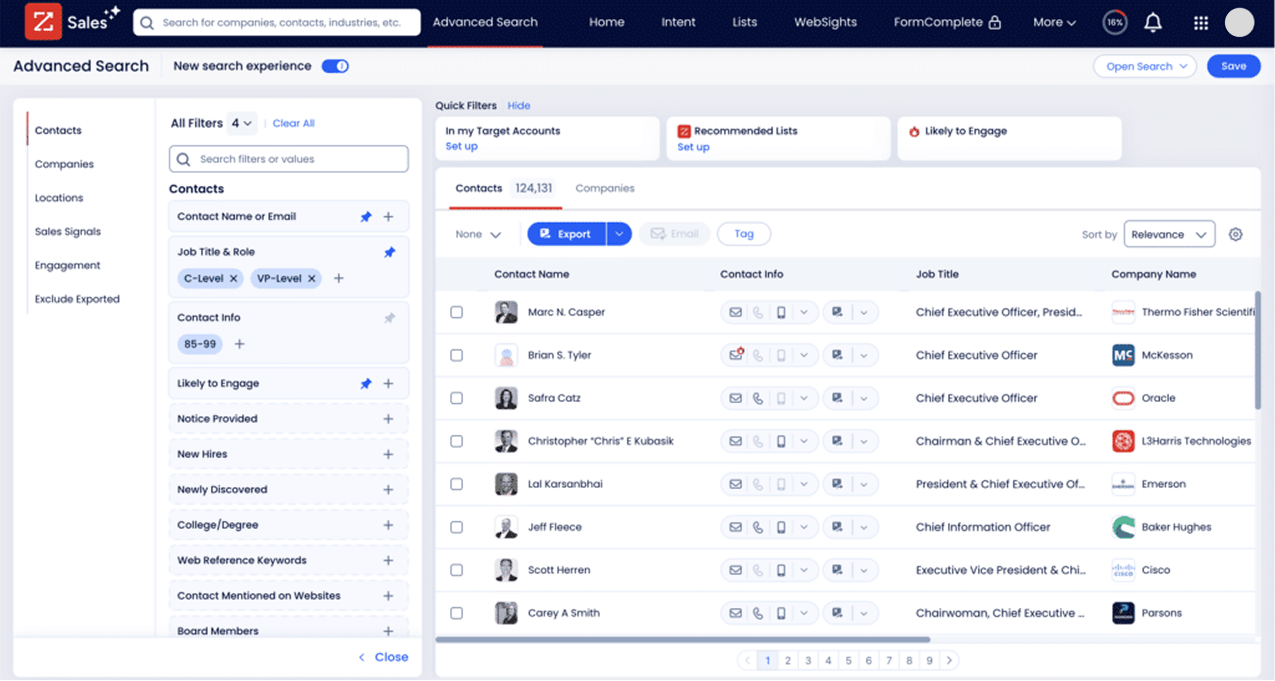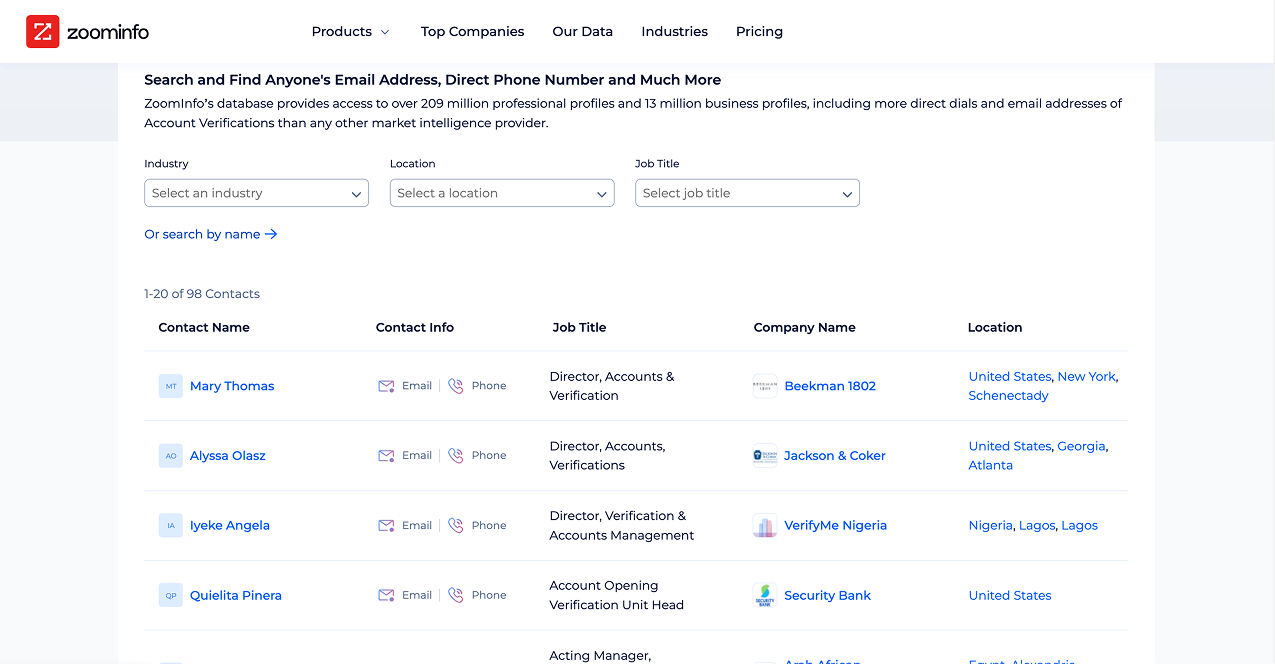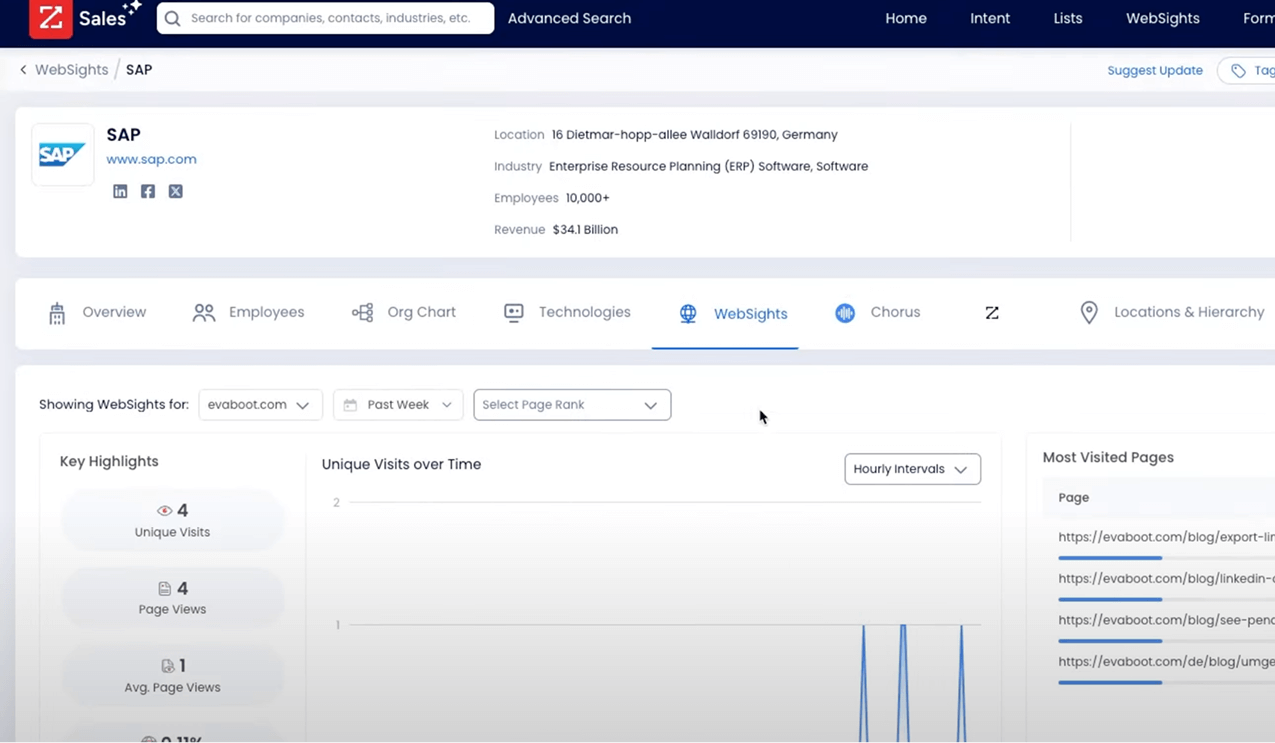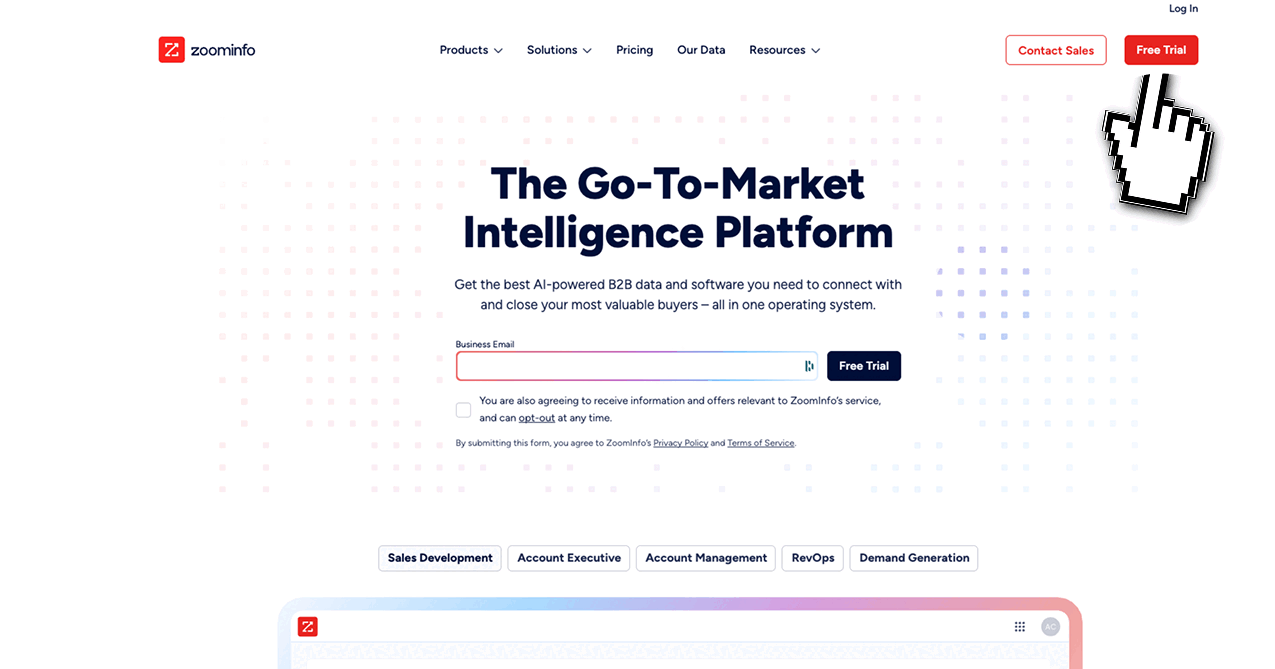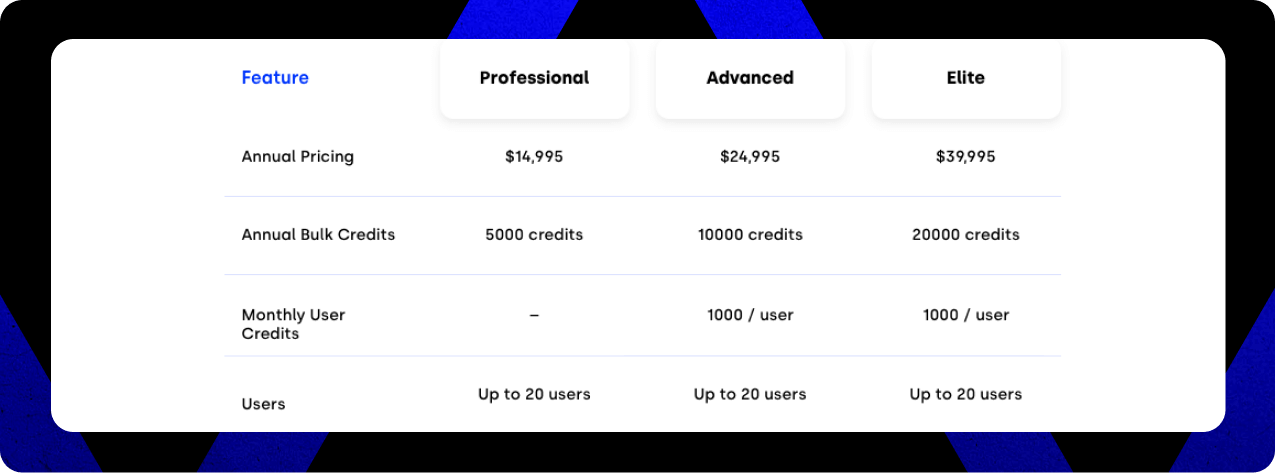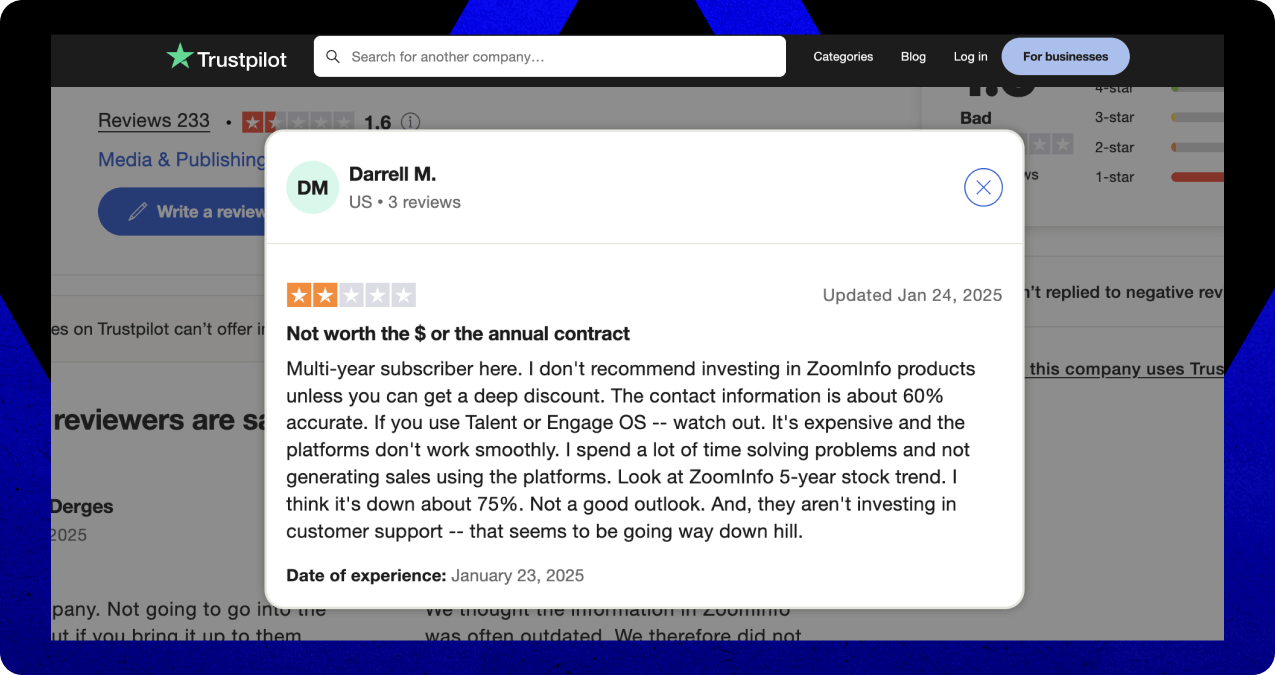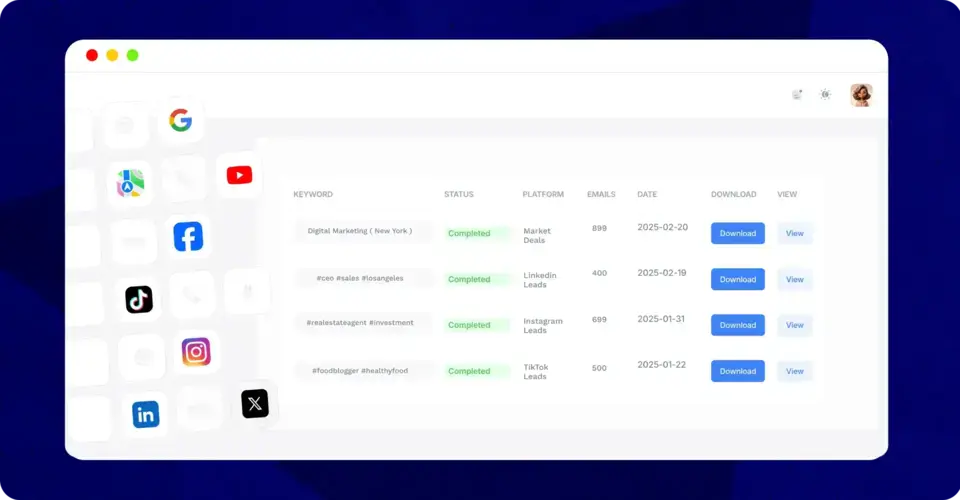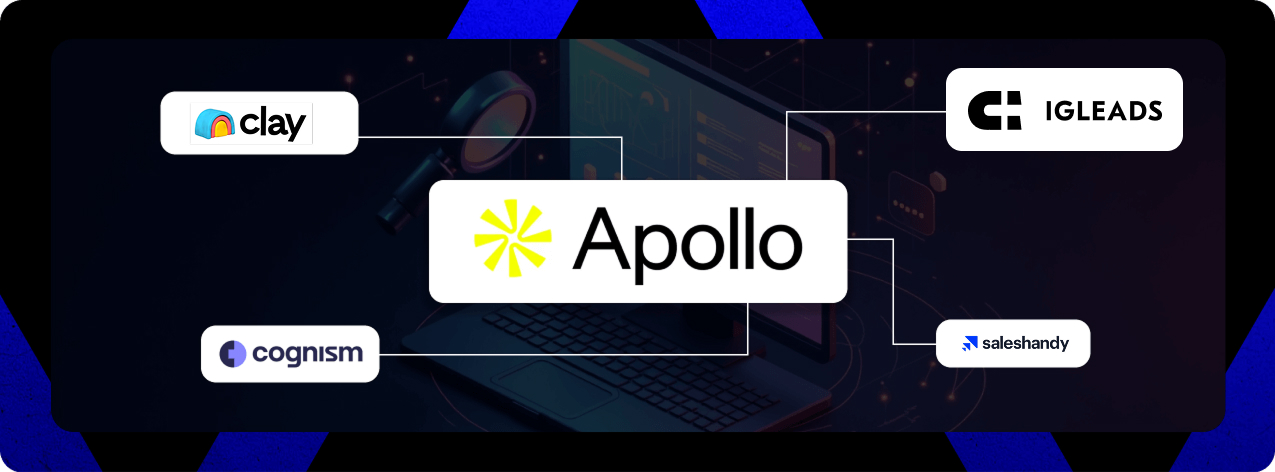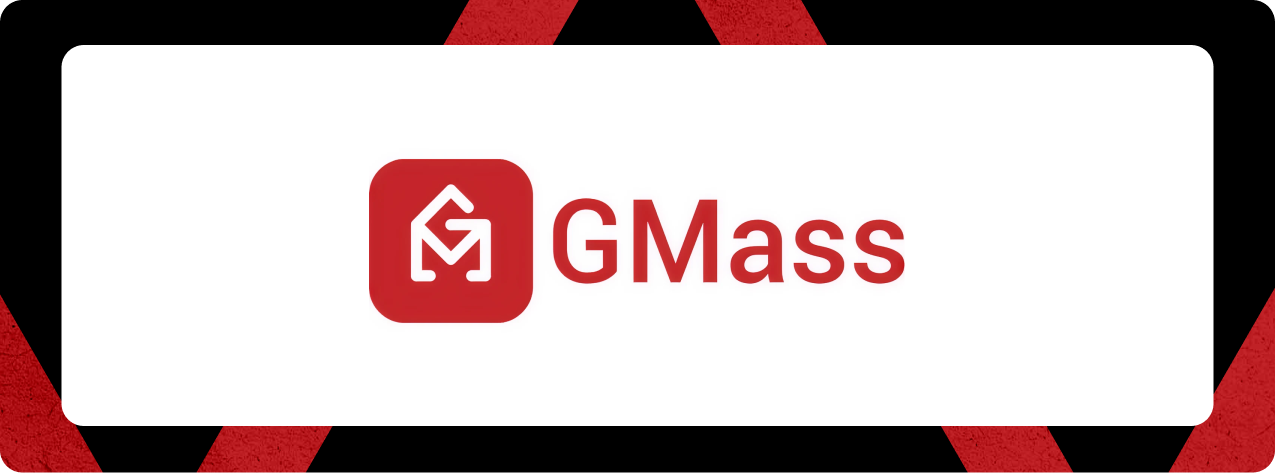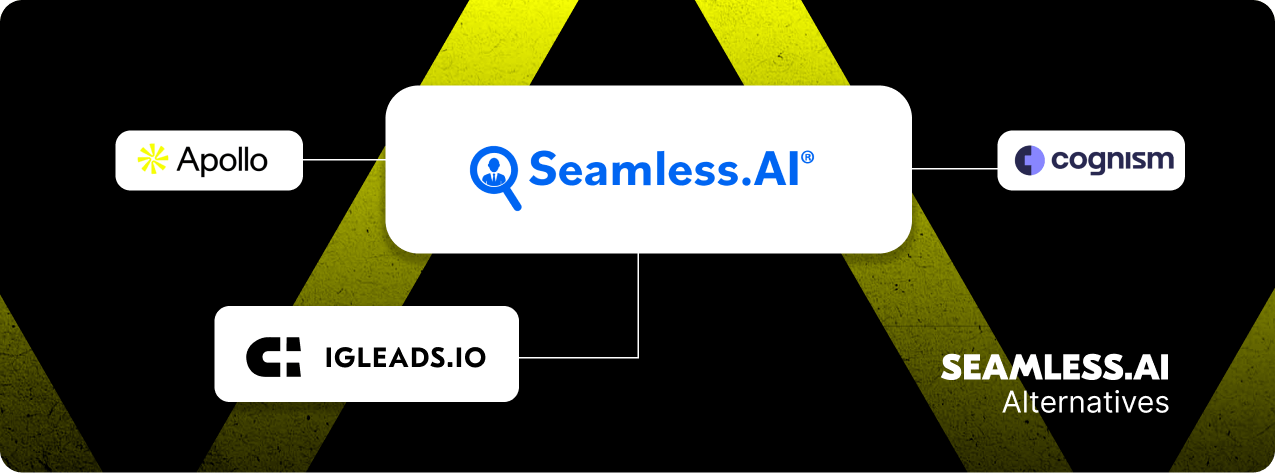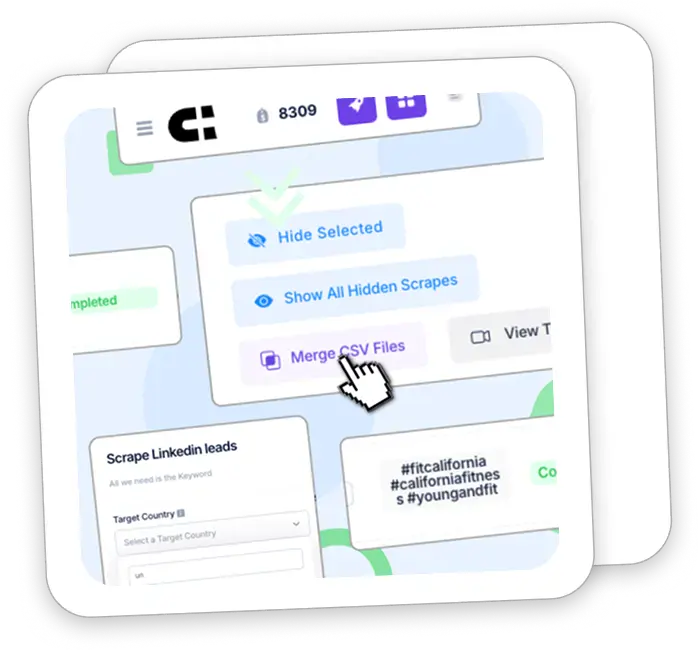ZoomInfo Review: What It Does, Who It’s For, and What Users Say
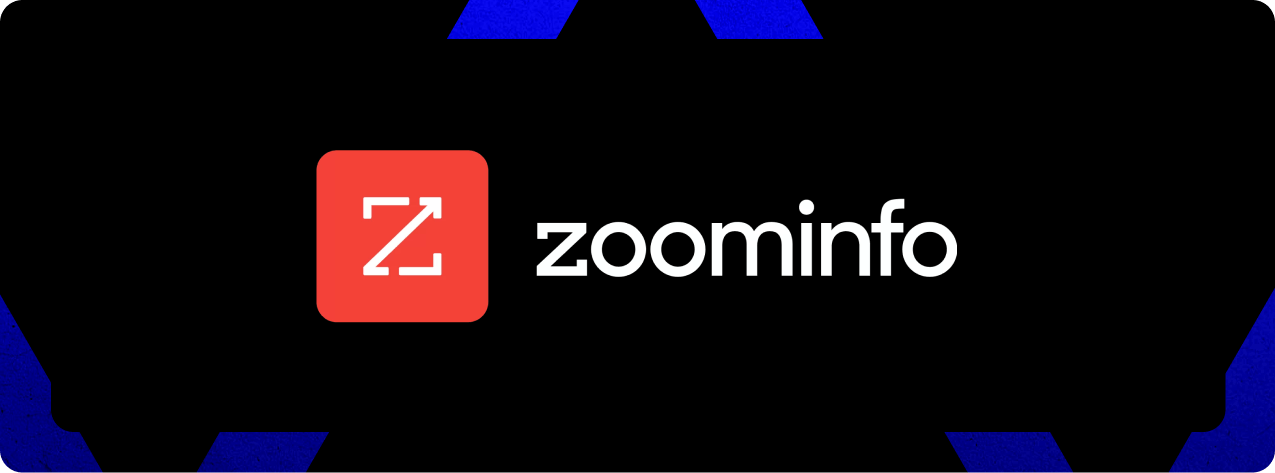
The B2B prospecting game has changed, and fast. ZoomInfo is used by over 30,000 companies including Google, Adobe, and Snowflake, with a database of 235+ million contacts and 100+ million company records. But the question isn’t whether it’s powerful. It’s whether it’s practical.
Here’s the truth:
Pros:
- Massive contact database
- Robust integrations
- Powerful sequencing tools
- Suited to enterprise-scale sales teams
Cons:
- Long onboarding
- Aggressive contracts
- Hidden credit limits
- Outdated data in key segments
Our Rating:
- Company Database ⭐⭐⭐⭐
- Intent Data ⭐⭐⭐
- Email Validation ⭐⭐⭐⭐
- Sales Automation Tool ⭐⭐⭐⭐
- Enrich & Data Integration ⭐⭐⭐
- Scoops & Org Charts ⭐⭐⭐
- Conversation Intel ⭐⭐⭐⭐
- API Access ⭐⭐⭐⭐
ZoomInfo delivers for big-budget sales orgs, but for leaner teams or fast-paced agencies, it’s often overkill.
If you’re tired of bloated software and just want clean, verified leads without the friction, IGLeads might be the move. We’ll walk you through exactly where ZoomInfo excels, where it stumbles in 2025, and what smarter alternatives can offer.
ZoomInfo under the microscope: helpful tool or feature overload?
ZoomInfo is one of the most well-known B2B lead generation and sales intelligence platforms on the market. It promises access to a massive contact database, enriched company data, and built-in tools for prospecting, outreach, and pipeline building.
In theory? It’s your all-in-one weapon to find decision-makers, understand your market, and close more deals.
But let’s zoom in on reality (pun intended): most ZoomInfo reviews from real users say the same thing. The database is big, no one denies that, but using the platform efficiently can feel like wrestling with a CRM that wants to do everything. But it doesn’t always do it well.
ZoomInfo is best suited for larger sales teams and enterprise workflows. Why? Because it’s expensive, packed with complex features, and often comes with long-term contracts. If you’re a lean team looking to build a nimble outbound machine, you might find yourself paying for a sledgehammer when all you needed was a scalpel.
Core Features of ZoomInfo
The foundation of ZoomInfo’s offering remains its massive database, which continues to be both its greatest strength and occasional weakness.
Contact & Company Database ⭐⭐⭐⭐
ZoomInfo’s core value lies in its expansive database: over 235 million professional profiles and 100+ million company records, organized by granular firmographics. Users can search and segment by job title, seniority, company revenue, headcount, industry, geography, and even technology stack. For B2B sales teams, this kind of depth makes it easier to build accurate target lists quickly.
Where ZoomInfo stands out is in the sheer volume and structure of the data. Its filtering tools are detailed, and bulk list-building is fast once you’re familiar with the interface. Data can be synced directly into CRMs like Salesforce or HubSpot, or exported as CSVs for external workflows.
That said, the platform’s data accuracy isn’t flawless. While U.S. contact records tend to be fairly reliable, international data can lag behind or include outdated details. Many users report bounce rates over 20%, particularly when working outside the core English-speaking markets. Some records also appear duplicated or lack key contact fields like direct dials.
Another limitation is credit-based access. Even on mid-tier plans, users often find themselves throttled by usage limits, especially when exporting data at scale or enriching large CRM segments. This makes ZoomInfo more viable for teams who can commit to higher-tier pricing or have a clear process for conserving credits.
Intent Data ⭐⭐⭐
ZoomInfo markets its intent data as a strategic edge, letting sales teams identify companies showing active interest in products or services based on web activity. This can include visits to specific pages, consumption of related content, or search behavior across the B2B web.
In theory, this helps prioritize outreach by surfacing “in-market” accounts already researching your category. For example, if your team sells cybersecurity software, ZoomInfo could highlight companies recently browsing similar tools or reading about ransomware defenses.
But in practice, many users find intent data less transparent than they’d like. It’s not always clear how ZoomInfo collects these signals, or how often the data is refreshed. The results can be hit-or-miss. While some users report improved conversion rates when layering in intent, others say the data feels generic, highlighting large companies that visit hundreds of pages weekly with little actionable insight.
The intent signals are scored, but ZoomInfo doesn’t always explain what differentiates a high score from a mid-range one. You also can’t see specific user activity, only general trends at the company level.
Email & Phone Validation ⭐⭐⭐⭐
ZoomInfo emphasizes its commitment to verified emails and direct dials, claiming rigorous validation through proprietary algorithms and third-party sources. It’s a key selling point, especially for outbound teams that depend on direct contact with decision-makers.
When it works, it’s a time-saver. Validated emails and phones are labeled accordingly, and these fields are included in most exports and CRM syncs. Sales reps can skip the guessing and jump straight into outreach.
That said, many users still report bounce rates between 15% and 30%, particularly when targeting small businesses or non-U.S. regions. While ZoomInfo performs better in enterprise and mid-market segments, its validation isn’t infallible. Some emails marked as “verified” still bounce, and not all phone numbers are direct dials, many lead to front desks or outdated listings.
Engage (Sales Automation Tool) ⭐⭐⭐⭐
ZoomInfo Engage is the platform’s native sales engagement tool, built to compete with standalone systems like Outreach or Apollo. It lets users create multichannel sequences that combine emails, call tasks, and LinkedIn steps, streamlining the entire outbound workflow within one interface.
Setup is intuitive: you can build templates, insert dynamic fields, track opens/clicks, and create task queues for reps. Activity data syncs with CRMs, and call outcomes can be logged in real time. This tight integration is ideal for teams that want everything under one roof.
However, Engage doesn’t offer the same level of customization or analytics as dedicated platforms. A/B testing is limited, conditional logic options are basic, and interface speed can lag during large-scale campaigns. Teams used to tools like Reply.io or Instantly might find Engage a bit rigid by comparison.
The biggest strength is convenience, especially for organizations already committed to ZoomInfo’s database. But for teams with highly specific workflows or automation needs, Engage might not fully replace more robust outreach platforms.
Enrich & Data Integration ⭐⭐⭐
ZoomInfo’s enrichment tools help teams fill in missing contact or company data directly within their CRM. It supports native integrations with platforms like Salesforce and HubSpot, making it easy to sync data fields automatically.
For large teams handling high lead volume, this can reduce manual entry and keep records up to date. Enrichment includes job titles, direct dials, company firmographics, and tech stack details, useful for segmentation and personalization.
ZoomInfo also offers a Chrome extension that embeds B2B contacts data through your browser. It lets sales teams pull verified emails, phone numbers, and company data directly while browsing LinkedIn, Salesforce, Gmail, or company websites.
However, enrichment credits are limited and tied to your plan. Once they’re used up, costs can rise quickly. Some users also report that enrichment occasionally overwrites existing CRM data or maps fields incorrectly, especially in more customized environments.
It’s a strong feature for scaling teams, but one that comes with added cost and a bit of setup friction.
Scoops & Org Charts ⭐⭐⭐
Scoops provide “insider” intel like new hires, department shifts, or planned tech investments. Org charts visualize company hierarchies and reporting structures. Both are meant to give sales teams more context when targeting key accounts.
In practice, Scoops are hit or miss. Some insights are timely and helpful, like a new CMO hire. Others are outdated or surface-level, offering little more than what LinkedIn already reveals.
Org charts are visually useful but often incomplete, especially for smaller or private companies. They can aid account mapping, but shouldn’t be relied on as the sole source of truth.
Overall, these features add value but don’t consistently deliver unique or exclusive insights.
Chorus (Conversation Intelligence) ⭐⭐⭐⭐
Chorus, acquired by ZoomInfo, analyzes sales calls to surface trends, objections, and rep performance. It’s useful for coaching, QA, and optimizing pitch delivery, especially for large sales teams making high call volumes.
The transcripts and keyword tagging are well executed, and call snippets can be shared easily across teams. Managers get dashboards showing talk ratios, topics, and deal risk indicators.
However, Chorus is only available in higher-tier plans, making it inaccessible to many SMBs. And for teams focused on email-first outreach, it may not be relevant.
API Access & Custom Workflows ⭐⭐⭐⭐
ZoomInfo offers a powerful API and workflow automation capabilities, but these are primarily reserved for higher-tier plans. If your team needs to enrich leads, trigger outbound workflows, or build integrations into internal tools, the API gives you that flexibility.
You can pull data directly into your CRM, trigger enrichment based on form fills, or set up custom lead routing logic. For enterprise users with dedicated ops teams, this can significantly streamline complex workflows.
The catch? Access isn’t included in lower-tier plans, and pricing for API usage is often negotiated separately. That means small or mid-sized teams may find it out of reach, or not cost-effective unless automation is core to their sales ops strategy.
Also, technical setup is required, if you don’t have dev resources or RevOps support, you may struggle to implement it cleanly. While ZoomInfo provides documentation, it assumes a certain level of technical know-how.
For larger teams building out custom sales systems, it’s a strong advantage. But for most SMBs, the value is locked behind both paywalls and engineering effort.
How to sign up for ZoomInfo
Getting started with ZoomInfo takes a few steps, and your setup choices will impact how useful the platform is for your team.
- Go to ZoomInfo.com and click “Get a Demo” or “Try for Free” (ZoomInfo doesn’t offer instant sign-up, access requires approval).
- Submit your business details, including a valid company email and role information.
- A ZoomInfo rep will contact you to schedule a walkthrough and discuss pricing.
- Once approved, your account is provisioned based on the chosen plan (Essentials, Advanced, or Elite).
- Integrate your CRM (like Salesforce or HubSpot), connect your email, and set user permissions.
- Start exploring contact lists, intent data, and enrichment tools, or set up workflows for automated prospecting.
Breaking Down ZoomInfo Pricing: Value vs. Cost
ZoomInfo pricing is tiered based on features, annual credits, and team size, with entry-level access gated behind a sales demo. While the Lite version offers extremely limited access, most serious users quickly need to upgrade to one of ZoomInfo’s enterprise plans.
Key points about ZoomInfo pricing:
- Professional Plan: Starts at around $14,995/year and includes 5,000 annual bulk credits. Typically covers up to three users, but additional users cost extra.
- Advanced Plan: Starts at $24,995/year and includes 10,000 credits, access to intent data, automation tools, and advanced filters. Suitable for growing sales teams that need deeper insights.
- Elite Plan: From $39,995/year, this tier unlocks the full platform, with high-volume credits, custom integrations, and premium support for enterprise use.
- ZoomInfo Lite (Community Edition): Free to access but highly limited, users share business contacts in exchange for a small number of monthly credits. Not practical for ongoing prospecting.
ZoomInfo’s annual pricing (no monthly billing) is shaped by your data needs, number of users, and required add-ons. Costs can rise quickly due to overages, expanded credits, API access, and extras like Worldwide Data or FormComplete. Be prepared for long-term contracts and scaling costs.
IGLeads Pricing Overview
Let’s talk money because this is where things get spicy. IGLeads doesn’t do per-seat, per-credit, or long contracts. Our pricing is flat, transparent, and aggressive by design:
Oh, and we offer free demos, no pushy salespeople required.
Real User Experiences with ZoomInfo
At the heart of ZoomInfo’s platform lies a comprehensive ecosystem that drives its industry-leading position in the market.
ZoomInfo gives users access to millions of verified contacts and companies. You can filter by firmographics, job title, revenue, tech stack, and more. It’s powerful, but it’s not always up to date, and you’ll hit credit limits quickly on most plans.
| ZoomInfo | Reviews Summary |
|---|---|
| Pros | Cons |
| ✅ Extensive contact database | ⚠️ Data accuracy issues |
| ✅ Powerful search and filtering tools | ⚠️ Limited customer support |
| ✅ Seamless CRM and email integration | ⚠️ Complex onboarding and UI |
| ✅ Advanced intent data and enrichment | ⚠️ High pricing with credit restrictions |
| ✅ Broad feature set for large sales teams | ⚠️ Overkill for lean or fast-moving teams |
Positive Aspects Highlighted in Reviews
When ZoomInfo does work, it delivers. Many sales teams and B2B marketers praise it for scale, data depth, and filtering options.
- Large Database: Users often mention the breadth of contacts and companies as ZoomInfo’s strongest asset.
- Filtering & Segmentation: Advanced filters help sales teams zero in on niche ICPs fast.
- CRM Integration: Seamless syncing with Salesforce and HubSpot gets points, especially at scale.
- All-in-One Sales Stack: Larger teams enjoy the convenience of having data, outreach, and enrichment tools under one roof.
It’s especially appreciated by enterprise users who can afford dedicated onboarding and have enough internal resources to build workflows around it.
Real User Takeaways
“ZoomInfo’s database is deep. We’ve closed deals using contacts we wouldn’t have found anywhere else.” — Sales Manager, B2B SaaS
“The integration with Salesforce makes our outbound much smoother. No more CSVs, no more guesswork.” — RevOps Lead
“When you learn to navigate it, it’s a powerhouse, but the learning curve is real.” — Account Executive, IT Services
Common Criticisms and Areas for Improvement
While many reviews start with praise, they often end with caveats, especially when it comes to usability, pricing, and transparency.
Here’s what most complaints have in common:
- Steep Pricing: ZoomInfo is expensive. Many reviews highlight the high cost per seat, unpredictable renewal fees, and the pressure to sign multi-year contracts.
- Data Quality Variability: Despite a huge database, users often complain about outdated emails, irrelevant contacts, or bounces, particularly in niche or non-U.S. markets.
- Opaque Contracts & Auto-Renewals: This is one of the biggest pain points. Users frequently mention how hard it is to cancel or get a refund.
- Clunky Interface: Compared to more modern platforms, the UI can feel outdated, slow, or unnecessarily complex.
- Customer Support Frustrations: Once you’ve signed, good luck. Support can be hit or miss depending on your plan tier.
Here’s how that sounds in the wild:
“It’s a solid product, but for the price we’re paying, I expect fewer bouncebacks.” — Marketing Director, FinTech
“We were stuck in a year-long contract. Renewal snuck up, and they wouldn’t let us downgrade.” — Startup Founder
“Feels like enterprise bloat. We ended up using 10% of what we paid for.” — Sales Ops, Growth Agency
Many users outgrow ZoomInfo… or never get the full value they hoped for. And that’s where lightweight, specialized tools like IGLeads come in.
Looking for a ZoomInfo alternative with no contracts, no bloat, and better value? Book your IGLeads demo and see how fast, flexible data can transform your pipeline.
Comparing ZoomInfo with IGLeads
Let’s get real: ZoomInfo isn’t the only option in 2025, and for many, it’s not even the best one.
If you’re running lean, moving fast, or tired of overpaying for clunky software and unclear contracts, you need to meet IGLeads. Our platform delivers clean, targeted lead data without the fluff, upsells, or support tickets.
Whether you’re replacing ZoomInfo entirely or just looking to add a sharper tool to your outbound stack, IGLeads is the refreshingly simple alternative built for people who actually care about ROI.
IGLeads Features and Benefits
IGLeads specializes in scraping and extracting verified lead data from the platforms that matter most today, not 2012.
- Targeted filters for Instagram, LinkedIn, Google Maps, and YouTube
- Location, keyword, and industry-specific lead scraping
- Scrapes only social media validated emails
- Unlimited exports (with Unlimited Plan) with no per-contact pricing traps
- Works with any outreach tool, no lock-in or integrations required
In short: you search, you get leads, you move. That’s it.
No bloated dashboards. No force-fed features. No “wait two weeks for onboarding.”
How IGLeads Complements ZoomInfo
Still stuck in a ZoomInfo contract? No problem. Many users run IGLeads alongside ZoomInfo to:
- Target platforms ZoomInfo ignores (like Instagram or Google Maps)
- Avoid paying extra for U.S. leads only (IGLeads works globally)
- Scrape fresh, ultra-specific lead lists for niche campaigns
- Reduce overage fees by using IGLeads for bulk scraping
Think of IGLeads as your tactical strike tool, the agile scout that fills the gaps your bulky CRM or legacy database can’t keep up with.
Cost-Benefit Analysis
| Feature | ZoomInfo | IGLeads |
| Monthly cost | ⚠️ Starts at $15,000/year (enterprise-level) | ✅ Starts at $49/month |
| Contract required | ✅ Yes (1–2 years) |  No No |
| Platform scraping | ⚠️ Limited | ✅ Instagram, LinkedIn, Maps, YouTube |
| Credit limits | ⚠️ Yes | ✅ Flat fee with no limits (on Unlimited Plan) |
| Usability | ⚠️ Complex | ✅ Plug-and-play |
| Support | ⚠️ Tier-based | ✅ Direct + fast |
| Ideal for | ⚠️ Large sales teams | ✅ Founders, solopreneurs, marketers |
If you’re running a scaled outbound team with heavy workflows in Salesforce, ZoomInfo might still make sense. But for the 99% who need fresh leads, fast, IGLeads gives you more control, more flexibility, and far less overhead.
Is ZoomInfo the Solution You’ve Been Looking For?
If you’re leading a large outbound sales team with complex workflows and deep CRM integrations, ZoomInfo might be exactly what you need. Its vast database, built-in outreach tools, and automation features are tailor-made for scale. You get access to over 235 million contacts, intent signals, validated phone numbers, and tools like Engage and Chorus to power enterprise-level operations.
But for smaller teams, fast-moving agencies, or solo operators? ZoomInfo often feels like using a sledgehammer to crack a nut. The platform is expensive, onboarding is slow, and hidden credit limits can create friction just when you need momentum. Many users report outdated data in niche or non-U.S. markets, clunky interfaces, and restrictive contracts that are hard to exit.
Bottom line: ZoomInfo delivers for big-budget sales orgs with time and resources to spare. But if you’re looking for a lean, fast, no-fluff alternative that just gets you verified leads—IGLeads is the better move. It skips the bloat, avoids the contracts, and keeps your pipeline full without locking you in.
Related to Zoominfo
- Lusha vs ZoomInfo in 2025: Which Sales Tool Should You Choose?
- UpLead vs ZoomInfo: Which Sales Tool Is Better for Your Business?
- Seamless.ai vs ZoomInfo: Which Sales Tool Saves You More in 2025?
- RocketReach vs ZoomInfo: Which One Is Better for Small Sales Teams?
- Apollo.io vs ZoomInfo: Which sales tool wins on pricing, data, and features in 2025?
- Looking for a ZoomInfo Alternative? Here Are the Top Options
- ZoomInfo Extension Overview – Features, Drawbacks, and Alternatives
- ZoomInfo Pricing: How Much Will It Cost You?
Frequently Asked Questions
Not really. While ZoomInfo offers powerful features, it’s often overkill for small businesses. The pricing alone, often locked behind annual contracts and per-seat models, can eat up most of a small team’s marketing budget. If you’re a startup, solopreneur, or small agency, a lighter, more flexible tool like IGLeads is likely a better fit.
ZoomInfo claims 95%+ accuracy, but real users tell a different story. U.S.-based data is generally solid, but once you move into international markets or niche industries, bounce rates go up. That’s why many marketers use tools like IGLeads to scrape verified leads from real-time platforms like LinkedIn or Instagram, rather than rely solely on static databases.
Yes. ZoomInfo integrates with major CRMs like Salesforce and HubSpot, plus tools like Outreach and Salesloft. That said, many integrations require higher-tier plans and additional setup. If you don’t need deep CRM sync and just want to get quality leads into your workflow fast, IGLeads works seamlessly with any outreach tool, no setup required.
Pros: Large contact database, detailed firmographics, CRM integrations, and multiple features under one roof. Cons: Expensive pricing, credit limits, outdated data in some markets, hard-to-cancel contracts, and a clunky UI. Many reviews echo the same message: powerful, but bloated, and not ideal for fast-moving teams or first-time buyers.
It depends on what you need. ZoomInfo is still a go-to for large B2B sales teams that want all-in-one platforms and don’t mind paying top dollar. But newer tools like IGLeads offer more agility, modern data sources, and simpler pricing, especially if you care more about results than dashboards.
